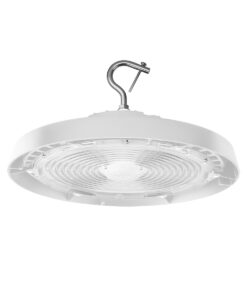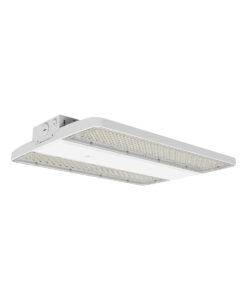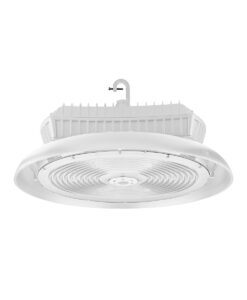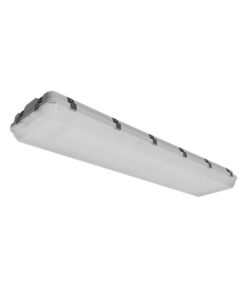Efficient warehouse lighting is a game-changer for operational success. It boosts productivity, enhances safety, and slashes energy costs.
At PacLights, we’ve seen firsthand how high efficiency warehouse lighting transforms industrial spaces. This guide will walk you through the best practices for optimizing your warehouse illumination.
Selecting Warehouse Lighting Fixtures
LED High Bay Lights: The Warehouse Workhorse
LED high bay lights transform warehouses with high ceilings. These powerful fixtures provide broad, uniform illumination across large areas. LED high bay lights can reduce energy consumption by up to 75% compared to traditional metal halide fixtures and have a lifespan of 50,000 hours or more.

When you select LED high bay lights, consider these factors:
- Lumen output: Try to use fixtures that produce around 22,500 lumens for ceilings 20-25 feet high. For ceilings over 35 feet, select 45,000 lumens or more.
- Color temperature: Choose between 4000K (neutral white) and 5000K (cool white) for optimal visibility and worker comfort.
- Beam angle: Wide beam angles (120-140 degrees) work well for general illumination, while narrower beams suit aisles and specific work areas better.
Linear LED Strip Lights: Versatile Illumination
Linear LED strip lights offer flexibility in warehouse lighting design. These fixtures illuminate aisles, shelving units, and workstations effectively. Their slim profile allows easy installation in tight spaces.
Key considerations for linear LED strip lights include:
- Length and modularity: Select strips that you can easily customize to fit your space.
- IP rating: Choose fixtures with at least an IP65 rating to protect against dust and moisture in industrial environments.
- Color rendering: Look for a Color Rendering Index (CRI) of 80 or higher to ensure accurate color perception (crucial for inventory management and quality control).
Task-Specific Lighting Solutions
Different warehouse areas require specialized lighting. For example:
- Loading docks: Use bright, glare-free LED fixtures to enhance safety during loading and unloading operations.
- Inspection areas: Implement high CRI lighting to ensure accurate color representation and defect detection.
- Cold storage: Choose LED fixtures rated for low-temperature environments to maintain performance in refrigerated spaces.
A careful selection of LED high bay lights, linear strips, and task-specific fixtures creates a comprehensive lighting solution that enhances productivity, safety, and energy efficiency in your warehouse. A thorough lighting audit and consultation with lighting professionals will determine the optimal fixture placement and specifications for your unique space.
The next step in optimizing your warehouse lighting involves strategic design principles that maximize the effectiveness of your chosen fixtures.
How to Optimize Warehouse Lighting Design
Strategic Fixture Placement for Maximum Coverage
Effective warehouse lighting design requires more than just installing fixtures. It demands a well-planned approach to create an environment that enhances productivity, safety, and energy efficiency.

To achieve maximum coverage, start with a thorough analysis of your warehouse layout. Consider ceiling height, aisle width, and shelf configuration. This information will guide your fixture placement decisions.
For high bay areas, space fixtures at 1.5 times the mounting height. This typically results in uniform illumination across the floor. In aisles, install linear LED strips directly above to eliminate shadows on shelves.
Don’t overlook vertical illumination. Proper lighting on vertical surfaces improves label reading and item location speed. Try to achieve a 3:1 ratio of horizontal to vertical illumination for optimal visibility.
Color Temperature Considerations for Productivity
Color temperature significantly impacts worker productivity and comfort. In warehouse environments, cooler color temperatures (5000K-6500K) often work best. These temperatures mimic natural daylight, which helps keep workers alert and focused.
However, this is not a one-size-fits-all solution. In areas where color accuracy is important (such as quality control stations), opt for a more neutral 4000K temperature. This provides better color rendering without sacrificing visibility.
Implementing Daylight Harvesting Techniques
Daylight harvesting techniques can significantly reduce energy consumption. Maximize the use of skylights and clerestory windows to allow natural light to penetrate deep into the warehouse space.
Combine these natural light sources with photosensors and dimming controls. As natural light levels increase, the artificial lighting automatically dims, maintaining consistent illumination levels while saving energy. Upgrading to LEDs can save both lighting and cooling energy in cold storage facilities, as LEDs convert more energy into light and less into heat.
The goal is to create a lighting design that adapts to changing conditions throughout the day. This not only saves energy but also creates a more comfortable working environment for your staff.
With these strategies in place, your warehouse lighting design will support the productivity and well-being of your workforce. The next step is to explore how smart lighting controls can further enhance your lighting system’s efficiency and functionality.
Smart Lighting Controls: How to Boost Warehouse Efficiency
Smart lighting controls revolutionize warehouse operations, offering unprecedented levels of efficiency and cost savings. These advanced systems can transform industrial spaces. Let’s explore the key components of smart lighting controls and how they can benefit your warehouse.
Motion Sensors and Occupancy Controls
Motion sensors and occupancy controls are game-changers in warehouse lighting efficiency. These devices ensure lights are only on when needed, significantly reducing energy waste. Occupancy sensors can increase lighting energy savings by 10% to 90% by turning off or turning down the lights when rooms are unoccupied.

To implement motion sensors effectively:
- Place sensors strategically in high-traffic areas like aisles and loading docks.
- Adjust sensitivity settings to prevent false triggers from small movements or vibrations.
- Use ultrasonic sensors for large, open areas and passive infrared sensors for smaller, more defined spaces.
Consider the specific needs of your warehouse. For example, in cold storage areas, choose sensors rated for low-temperature environments to ensure reliable operation.
Automated Dimming Systems
Automated dimming systems take energy efficiency to the next level. These systems adjust light levels based on available natural light or specific task requirements.
To maximize the benefits of automated dimming:
- Install photosensors near windows or skylights to detect natural light levels.
- Group fixtures in zones based on daylight availability and task requirements.
- Program gradual dimming transitions to avoid sudden changes that could distract workers.
Automated dimming not only saves energy but also extends the life of your LED fixtures (by reducing their overall operating time at full power).
Networked Lighting Control Systems
Networked lighting control systems represent the pinnacle of smart lighting technology. These systems connect all lighting fixtures to a central management platform, offering unparalleled control and data insights.
Key benefits of networked lighting control systems include:
- Real-time energy consumption monitoring
- Automated scheduling based on warehouse operations
- Remote control and troubleshooting capabilities
- Integration with other building systems for comprehensive energy management
To implement a networked lighting control system:
- Choose a system that’s scalable and compatible with your existing infrastructure.
- Train your staff on how to use the system effectively.
- Regularly analyze the data provided by the system to identify further optimization opportunities.
Smart lighting control strategies can significantly reduce energy consumption, lower maintenance costs, and create a more responsive and efficient lighting system for your warehouse. The initial investment in these technologies often pays for itself quickly through energy savings and improved operational efficiency.
High efficiency warehouse lighting transforms industrial facilities. LED fixtures, strategic placement, and smart controls optimize illumination for various work areas. These solutions enhance visibility, reduce errors, and increase overall productivity while slashing energy bills and maintenance costs.

The future of warehouse illumination promises exciting advancements. We expect improvements in LED efficiency and the integration of artificial intelligence for predictive lighting controls. These innovations will create more responsive and efficient industrial environments, further reducing energy consumption and operational costs.
PacLights remains committed to leading the charge in warehouse lighting innovation. Our high efficiency warehouse lighting solutions meet the evolving needs of modern industrial spaces. We offer comprehensive lighting systems that drive operational excellence and sustainability, helping warehouse operators illuminate their path to a more efficient and cost-effective future.






Disclaimer: PacLights is not responsible for any actions taken based on the suggestions and information provided in this article, and readers should consult local building and electrical codes for proper guidance.